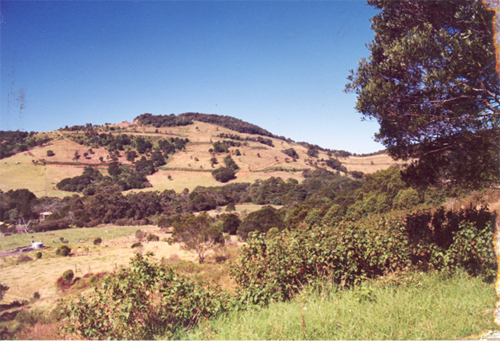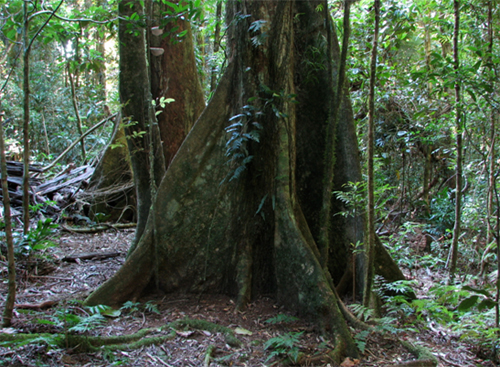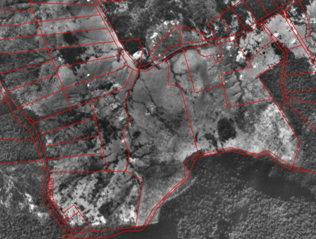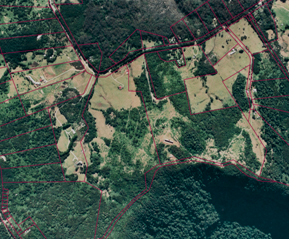|
Broadly, the challenge is to recreate the myriad and complex relationships and feedback interactions between all the organisms of an ecosystem, from towering trees to the millions of microorganisms in the soils. These complex dynamic interactions involving many types of feedback loops are the foundations of ecosystem resilience —its capacity to weather future shocks that nature or humans incur.
 The challenge is to go from this (Mt Springbrook in the Boy-ull Creek catchment in 1994
The challenge is to go from this (Mt Springbrook in the Boy-ull Creek catchment in 1994
and a major focus of our restoration activities) -

to this in the very long-term: mature rainforest in the nearby Reference Site in less impacted Ee-jung Creek catchment —
viable habitat for Lyrebirds, Logrunners and other ancient lineages.
Photo: Aila Keto
|
Real challenges face us including:
• Bringing back to their original state complex and diverse rainforest ecosystems harbouring those ancient lineages of plants and animals that give the World Heritage area its outstanding universal value
• Determining, as far as possible, what the original state actually was before it was disturbed, degraded, or cleared?
• Dealing with possible loss of key components of the original species pool?
• Ensuring all essential pollinators, disperses and other key functional groups are present or recovered
• Reversing any degradation of soils or hydrological functions that could hinder recovery of original communities
• Detecting any abnormal ecosystem functioning (nutrient cycling etc) that could divert successional processes towards an undesirable state from which recovery could be more difficult and costly
• Ensuring the broader landscape context is sufficiently connected for effective movement of species that is essential for their long-term survival; this challenge involves thinking about effective partnerships across relevant jurisdictions and landowners
• Controlling the weed menace that smothers and out-competes native species
• Understanding the habitat requirements of species in most needs
• Coping with potential impacts of climate change that could make full restoration of these ‘ancient’ rainforests too difficult; the challenging question is “what is achievable?”
To meet these challenges requires thinking about many things:
1 an understanding of how the present was shaped by the past,
2 an understanding of how ecosystems develop and function normally,
3 what barriers might block recovery; how great are the risks of not achieving our goals,
4 what approach is best to succeed under each circumstance we find across the landscape,
5 what resources are needed to carry out needed works and for as long as is necessary,
6 what partnerships are needed to address connectivity conservation and security of land issues, and
7 what process is best for integrating vast amounts of information, monitoring and reporting progress and adapting to changed circumstances or understanding.
1. Understanding how the present was shaped by the past
Reports, recollections of long-term residents and historical photographs including aerial photographs we have acquired that date as far back as the 1930s have helped understand how the present was shaped by the past.
The opening up of places like Springbrook at the turn of last century was advocated by government policy at the time. Clearing continued from the time of settlement in 1906 until about 1975 by which time almost the entire 2000 hectare plateau area had been cleared. Most accessible areas were logged for timber. The main economic base in the past was dairying and grazing, with horticulture flourishing in the 50s and 60s but as those industries failed, ecotourism filled the void gradually building from as far back as the 1920s. A tourism revival since the 1980s has mostly been based on the areas natural values. Cleared areas, mainly on steeper slopes, were left to recover naturally. About 65 percent of the plateau has been recolonised by rainforest but its habitat quality is largely unknown. Most ridgelines have been roaded to dispersed dwellings and lookouts and virtually all steams damned or diverted to various degrees for farming, horticulture or livestock. Exotic pasture grasses were extensively cultivated, and in some cases aerially sown. Policy conflicts still exist. One state government department classifies sections of Springbook as “good quality agriculture land” requiring Local Government to ensure these cleared areas remain cleared whilst another acquires these tracts for restoration of forest cover. The majority of dwellings have been surrounded by gardens of exotic species increasing the danger of escapes into the surrounding World Heritage Area. A policy vacuum exists on corridor management that would be compatible with World Heritage protection. Weed species are increasing and new more dangerous shade-tolerant types emerging.
2. Understanding how ecosystems work
If one wants to go beyond prescriptions or a simple trial and error approach and risk failure, understanding how ecosystems work is important and articulating a conceptual model(s) is an important first step. Applying insights and tools from ecological restoration science is both challenging and immensely helpful — especially when restoration involves trying to recreate the myriad and complex relationships and feedback interactions between all the organisms of an ecosystem, from towering trees to the millions of microorganisms in the soils. And especially knowing that these complex dynamic interactions involving many types of feedback loops are the foundations of ecosystem resilience —its capacity to weather future shocks that nature or humans incur. Today we recognize that regenerating ecosystems don’t automatically progress, via a simple process of succession, to a fixed and predictable end point. The complex interplay between a donor species pool, resource availability, trophic and other species interactions, and the prevailing disturbance regime can lead to surprising results and sometimes precipitous shifts to unwanted and intractable ecosystems dominated by species completely unlike those we want to recover. Our response to these challenges is described in more detail in the Science pages of this website.
3. Barriers and risks to recovery
Present day mosaics of regrowth and cleared areas on the Springbrook plateau have variously been affected by a complex history of clearing, logging, grazing, horticulture, fertilizer and herbicide use, soil disturbance, water extraction, stream diversion, fire, weed invasions, feral animal and pathogen introductions, and infrastructure development associated with increasing urbanization and visitor demands.
These land-use changes can affect the potential pool of colonisers, the availability of viable seeds, the structure and condition of soils and hence nutrient and water availability essential for growth, as well as changing microclimates and disturbance regimes that impact on ecosystem interactions including recruitment, growth, and mortality of regenerating native species.
Along with these potential changes, normal species interactions (between species and with the environment) can be drastically altered so that traditional successional processes cannot be expected. In fact, more often than not, ecosystems are capable of complex dynamics with surprising and sudden, possibly irreversible, changes to alternative stable states.
Our challenge is knowing if or when nature needs our help. we are needed to help steer the successional trajectory through this complexity and uncertainty towards a community of native species that becomes self-organising and self-sustaining and ultimately closely resembling the original vegetation to ensure World Heritage values do survive.
A number of science projects are being conducted to help us answer these questions.
An assessment of risks was conducted and documented in our foundation report available on this and the Queensland Government’s websites.
4. Choice of approaches
How we meet our goals and objectives depends on the size of restoration areas, their degree of clearing and isolation and many other factors including the degree of urgency for restoring critical wildlife habitat. One hundred and four (104) species of plants and other wildlife at Springbrook are threatened with extinction.
One of our first steps was to clearly frame the scope of our project. An overriding principle and check to all our approaches has been to “cause no harm” and “do the best one possibly can”.
Traditional approaches of planting can be prohibitively expensive at larger scales and may lack resilience to climate pressures in the long term.
Our choice has been to work with and learn from nature itself to the greatest possible extent, intervening only when absolutely necessary. Determining if and when is easier said than done, so we have designed monitoring programs based on an ecological conceptual model described elsewhere, to guide us. Our catchment-wide wireless sensor network to monitor environmental conditions is the largest in the world and has won prizes for innovative technology. There are more details of this in “Partnerships” and “Projects” pages.
5. Addressing resource constraints
Ecological restoration of necessity takes time and considerable resources. Philanthropy and grants, whilst of immense value, are unreliable sources of sustainable funding. Without adequate resources, restoration goals are unachievable.
Our choice has been to invest in two ecotourism businesses where all profits are directed towards the Springbrook Rescue project. A license agreement exists between ARCS and our partners (the Queensland Government who owns the land) providing sustainability for this funding source. ARCS involvement is pro bono, allowing our “in kind” resources to be transformed to “cash” that buys materials and equipment and pays for maintenance and volunteer support expenses.
6. Developing partnerships
Facing the challenges of connectivity conservation needs partnerships or working relationships with landowners, land managers and especially the local community. These relationships, if built on trust and common purpose, take time to develop and sustain. The World Heritage Convention was based on cooperation from inception, and requires that World Heritage has a function in the community. Our project aims to fulfill this obligation and achieve that cooperation.
Long-term security of land is vital for ensuring the long-term health and resilience of ecological communities being restored. National Park tenure provides the highest level of security for nature to survive and thrive. Almost all lands acquired in association with Springbrook Rescue are now either National Park or National Park (Recovery). The remaining properties are slated for transfers at the end of this long-term Project or after encumbrances have been settled.
The question of who should actually do the on-ground work has been an interesting one to resolve. Some recommended paid contractors for reliable, on-time delivery. Others recommended outsourcing volunteer recruitment to organisations such as Conservation Volunteers Australia. Our choice has been for ARCS to become fully engaged with volunteers — meeting the challenge of inspiring the community to share this opportunity to recreate a viable National Park of immense significance. To make it easier for us initially we have tended to work with groups such as bird watchers, bushwalkers and religious groups that self organize and become committed to the project. Friendships based on deep bonds of respect and trust are formed or renewed, experiences are shared. Laughter is ever present. In the evenings the fire is lit, musicians play, songs are sung and food is shared in celebration. For many working amongst ancestral songbirds and enveloping clouds on this island in the sky is transformative. We welcome people from anywhere in the world to share this experience.
7. Learning and adapting from experience
There are no single prescriptions for how to restore forests that were lost. Meeting our many challenges is a continual learning experience.
Our approach has been centred on a social ecological systems framework, relying on ecological conceptual models to interpret and apply the lessons of history and current management in terms of ecosystem functioning. Science projects gather required information which is analysed, shared and fed back into reviews of our approaches and assumptions. These are detailed in the following pages of this website and our published reports.
Here are images of some of the challenges and opportunities facing us:

The high country on Springbrook Plateau at 1930 |

The same area at 1989 |
|